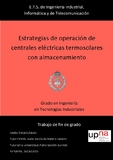Mostrar el registro sencillo del ítem
Estrategias de operación de centrales eléctricas termosolares con almacenamiento
| dc.creator | Erdocia Zabala, Ioseba | es_ES |
| dc.date.accessioned | 2015-11-12T10:18:12Z | |
| dc.date.available | 2020-06-26T23:00:09Z | |
| dc.date.issued | 2015 | |
| dc.identifier.uri | https://hdl.handle.net/2454/19154 | |
| dc.description.abstract | The increase of electric power demand and the wish to protect the environment are leading to a change in the energy sources. Conventional energy plants are losing strength against the renewable energy plants and, in particular, solar energy plants have a huge potential to provide clean energy supply for the increasing world’s energy demand. Among the existing solar technologies, Concentrating Solar Power (CSP) is one of the most promising technologies. One of the major advantages of CSP plants is the technically feasible and cost-effective integration of Thermal Energy Storage (TES) systems. To increase the plant dispatchability, it is possible to create different operational strategies defining how such TES system is used. In this work, different strategies with different overall goals have been simulated over a complete year and the results are presented and compared here to demonstrate the capabilities of the operational strategies towards an increased dispatchability and plant economic effectiveness. The analysis shows that different strategies may lead to significant differences in the plant annual production, expected economic incomes, number of power block stops, mean efficiency, etc. Specifically, it has been found that the economic incomes of a plant can be increased (+1.3%) even with a decreased total energy production (-1.5%) if the production is scheduled to follow a demand/price curve. Also, dramatic reduction in the number of turbine stops (-67%) can be achieved if the plant is operated towards this objective. The strategies presented in this study have not been optimized towards any specific objective, but only created to show the potential of well designed operational strategies in CSP plants. Therefore, many other strategies as well as optimized versions of the strategies explained below are possible and will be analyzed in future works. | en |
| dc.format.mimetype | application/pdf | en |
| dc.language.iso | eng | en |
| dc.subject | Concentrating solar power | en |
| dc.subject | Thermal energy storage | en |
| dc.subject | Energy management | en |
| dc.subject | Energy dispatchability | en |
| dc.subject | Operational strategies | en |
| dc.subject | Plant modeling | en |
| dc.subject | Plant simulation | en |
| dc.title | Estrategias de operación de centrales eléctricas termosolares con almacenamiento | es_ES |
| dc.type | Trabajo Fin de Grado/Gradu Amaierako Lana | es |
| dc.type | info:eu-repo/semantics/bachelorThesis | en |
| dc.date.updated | 2015-11-02T13:54:03Z | |
| dc.contributor.affiliation | Escuela Técnica Superior de Ingenieros Industriales y de Telecomunicación | es_ES |
| dc.contributor.affiliation | Telekomunikazio eta Industria Ingeniarien Goi Mailako Eskola Teknikoa | eu |
| dc.description.degree | Graduado o Graduada en Ingeniería en Tecnologías Industriales por la Universidad Pública de Navarra | es_ES |
| dc.description.degree | Industria Teknologietako Ingeniaritzan Graduatua Nafarroako Unibertsitate Publikoan | eu |
| dc.rights.accessRights | Acceso abierto / Sarbide irekia | es |
| dc.rights.accessRights | info:eu-repo/semantics/openAccess | en |
| dc.embargo.terms | 2020-06-26 | es_ES |
| dc.contributor.advisorTFE | Sanchis Gúrpide, Pablo | es_ES |
| dc.contributor.advisorTFE | García-Barberena Labiano, Javier | es_ES |


